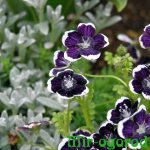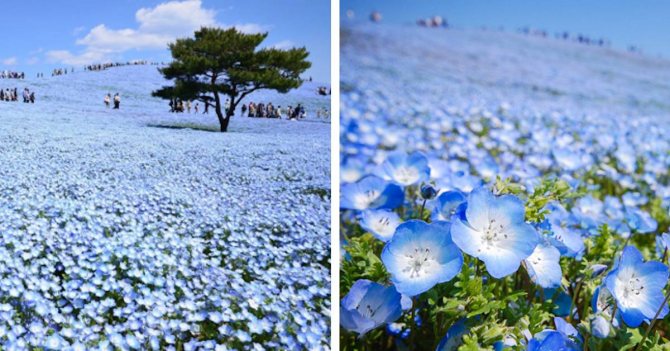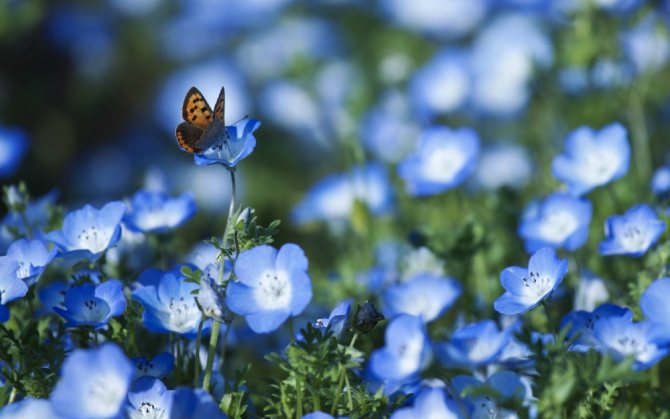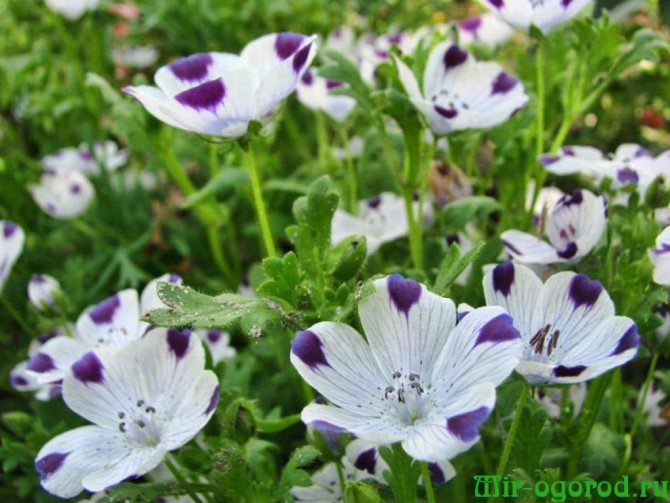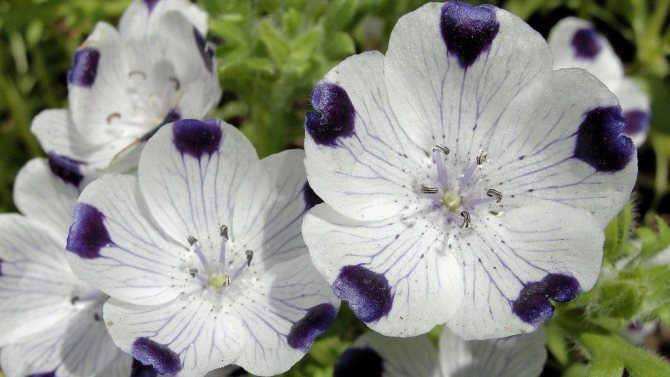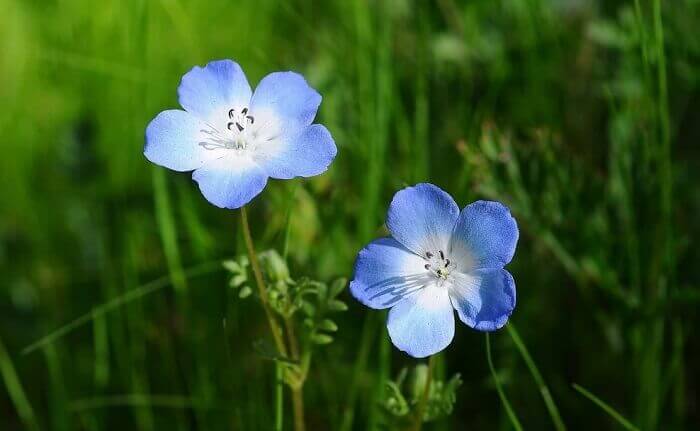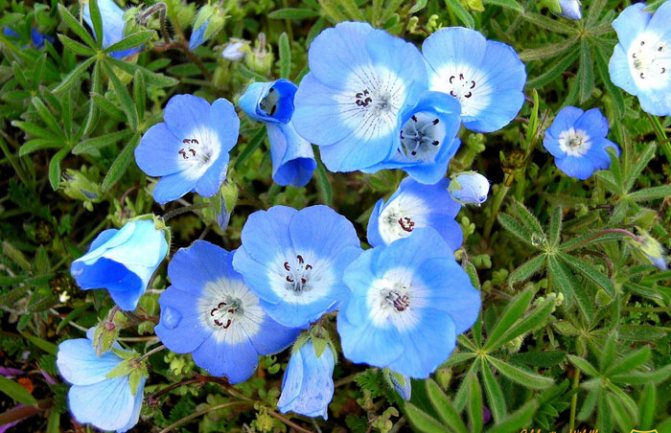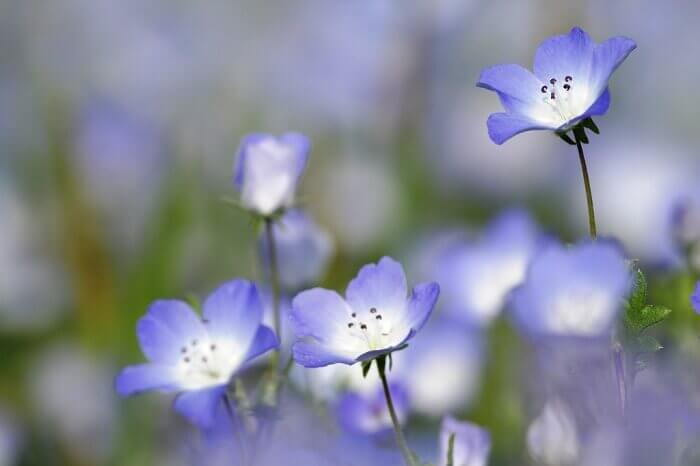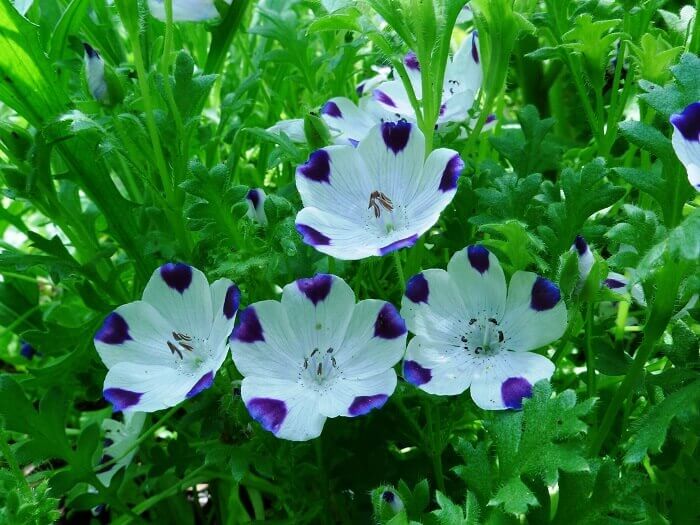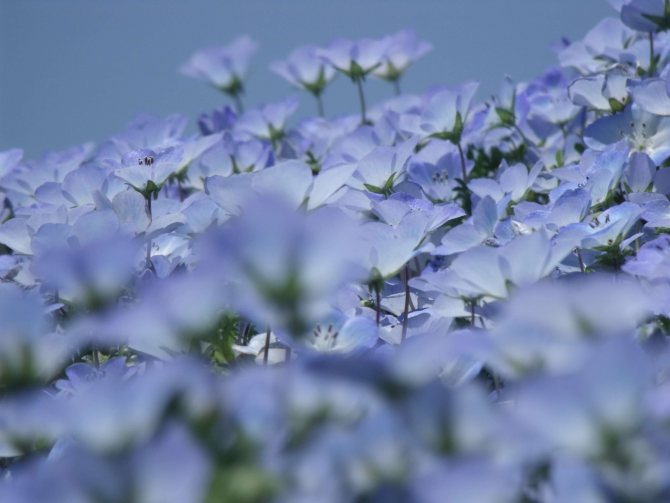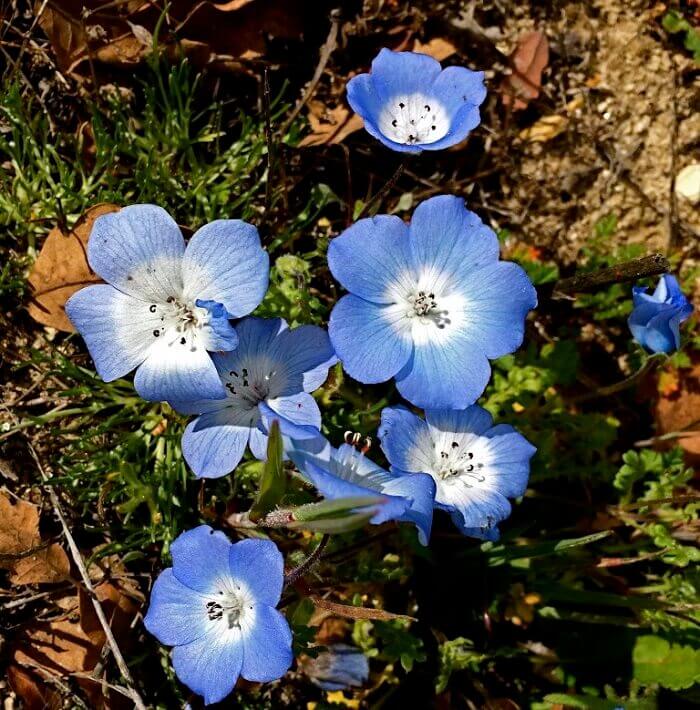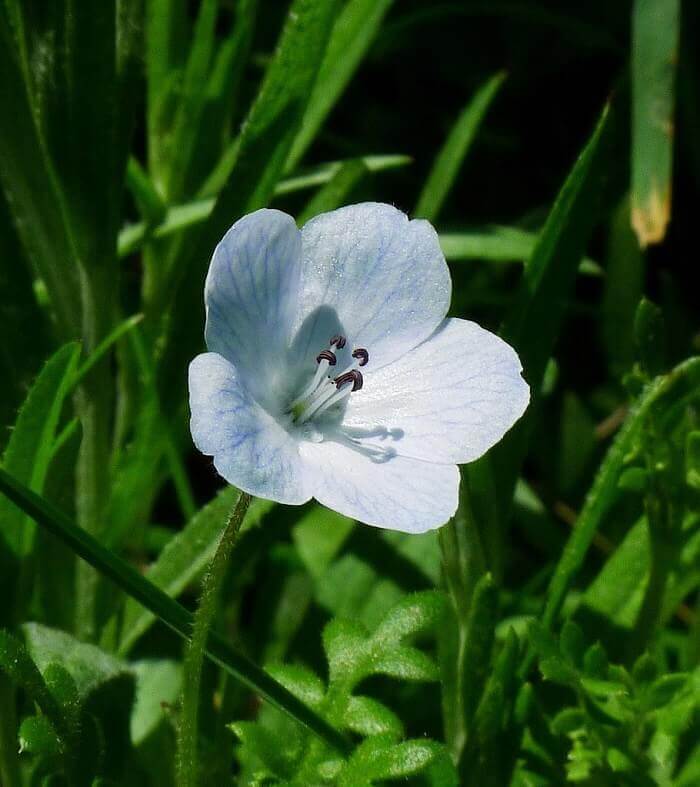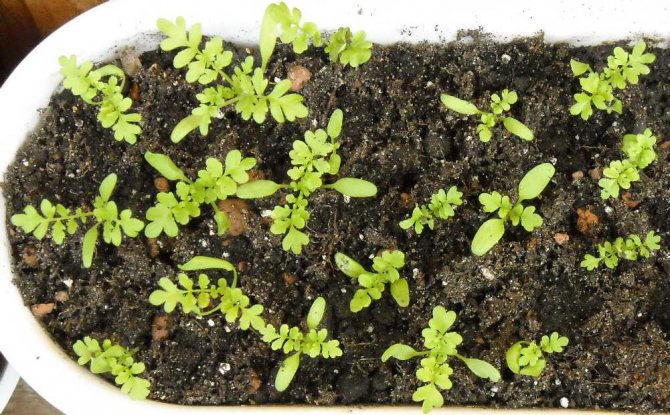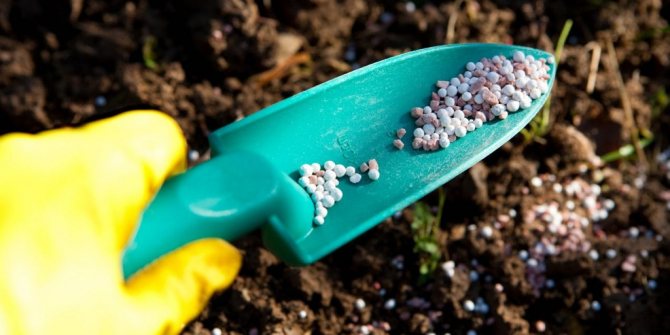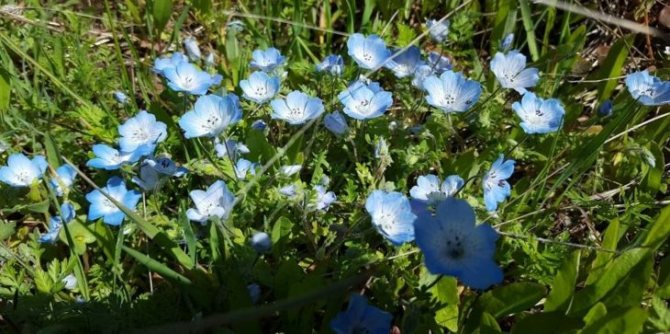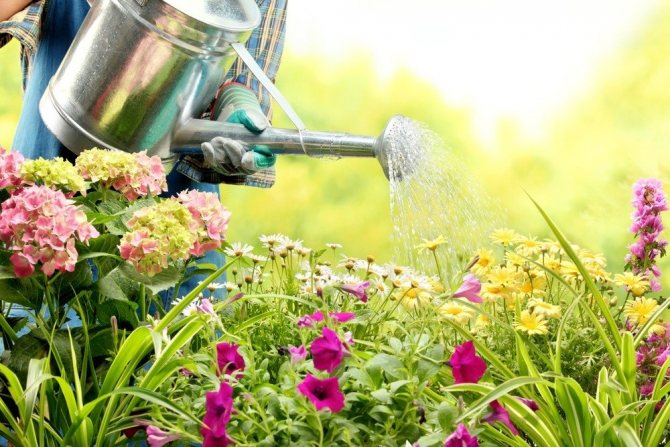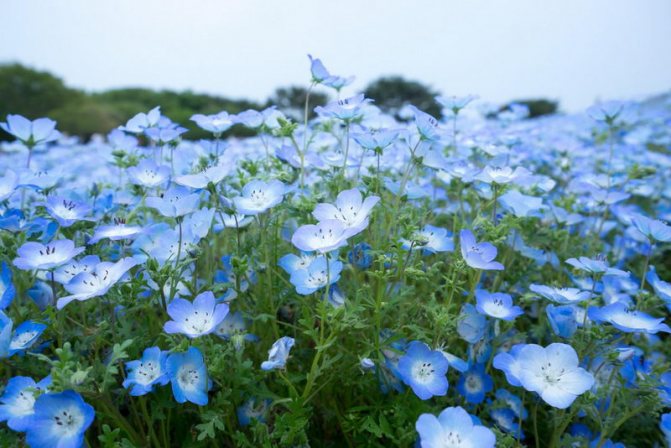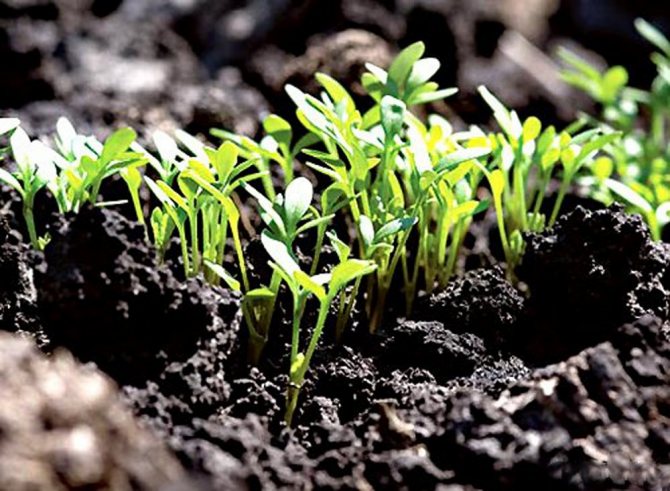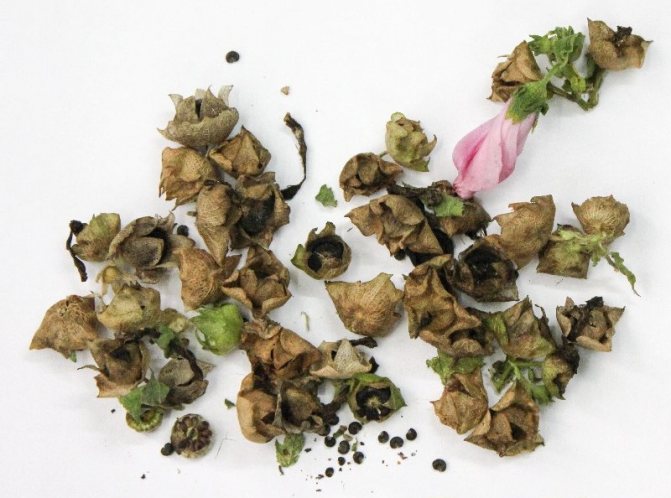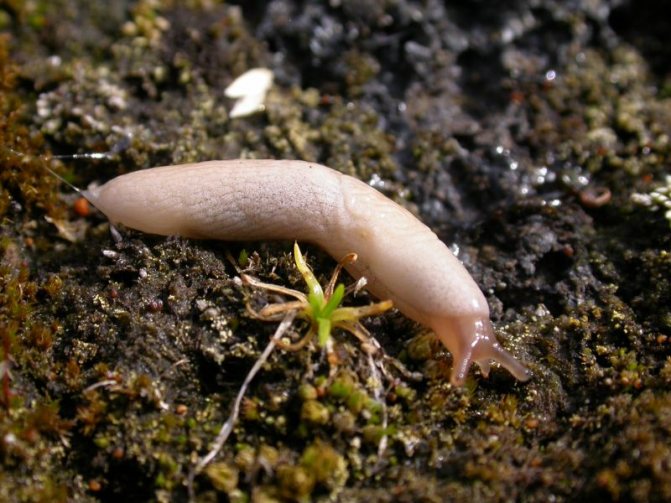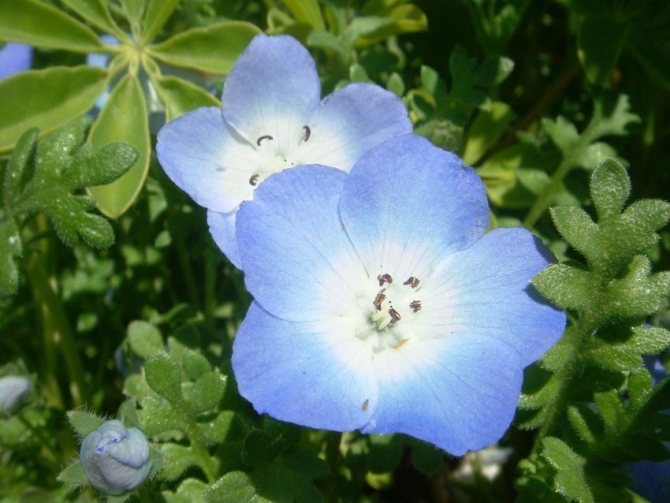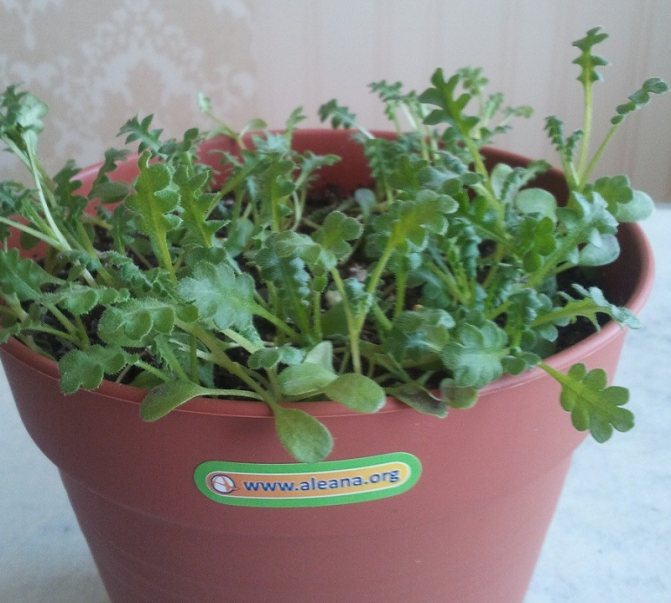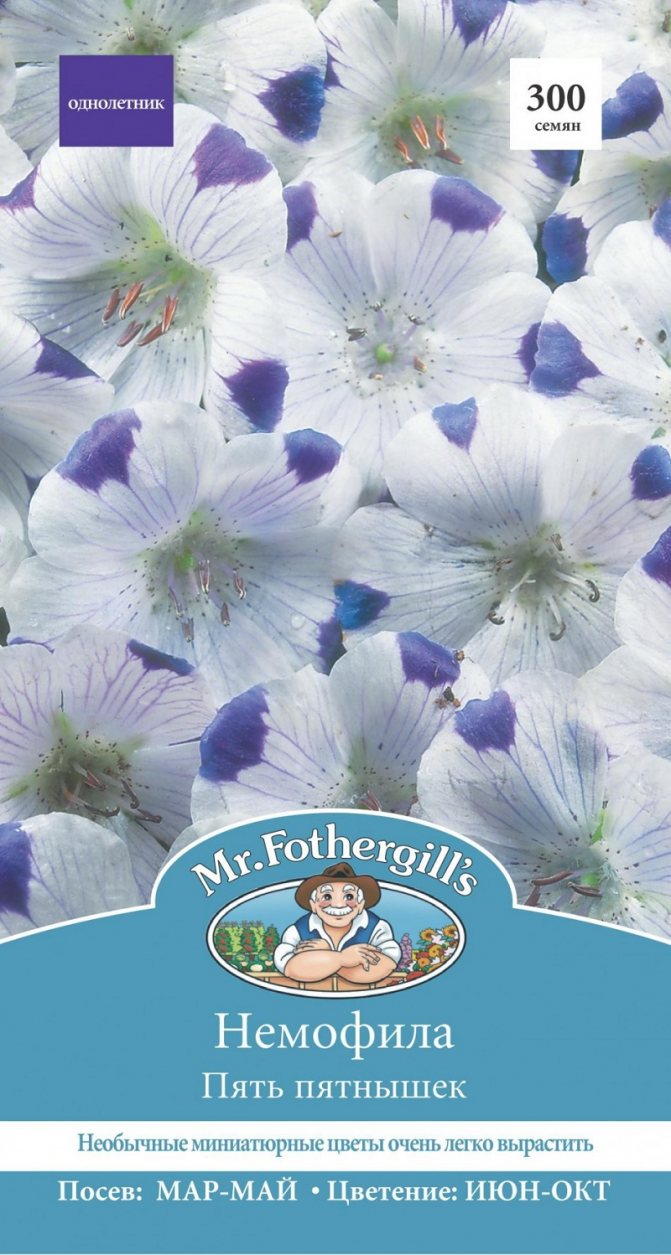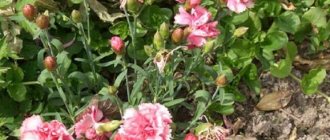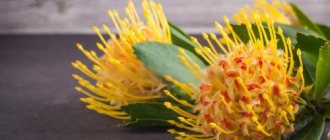A small plant with the English name Baby Blue Eyes, or girlish blue eyes, is a nemophila. She is not always blue, but always full of charm. Nemophiles in nature are most often found in thickets, in the forests of North America, especially in California. Some species are grown as annual, fast growing ornamental plants. The most popular is the nemophila mencis, also known as blue. Planting, care and cultivation from nemophila seeds, photos of popular species and varieties, application in landscape design are presented in this article.
Nemophila description
Nemophila is a groundcover annual plant native to America. The delicate flowers of nemophila, resembling large buttercups in shape, are called blue-eyed in their homeland. Our nemophila blooms at the end of June. The plant has creeping pubescent stems up to 30 cm in length, exactly the same pubescent leaves. There are several varieties of nemophila with flowers of various colors.
Fresh articles about garden and vegetable garden
Ants on trees: how to fight?
Mulching film: what is it?
Powdery mildew on indoor plants: prevention and treatment
Nemophila blue "Children's blue eyes". Its flowers are broadly bell-shaped, bright blue, up to 4 cm in diameter. There are flowers with a color from white to blue-white.
Nemophila spotted "Ladybug", flowers are also broadly bell-shaped, up to 4.5 cm in diameter, white, with a bluish or purple speck at the tip of each petal.
Nemophila purple "Black Penny" flowers have a rich purple, almost black color, with a white edging around the edges of the petals. All types of nemophila are very beautiful.
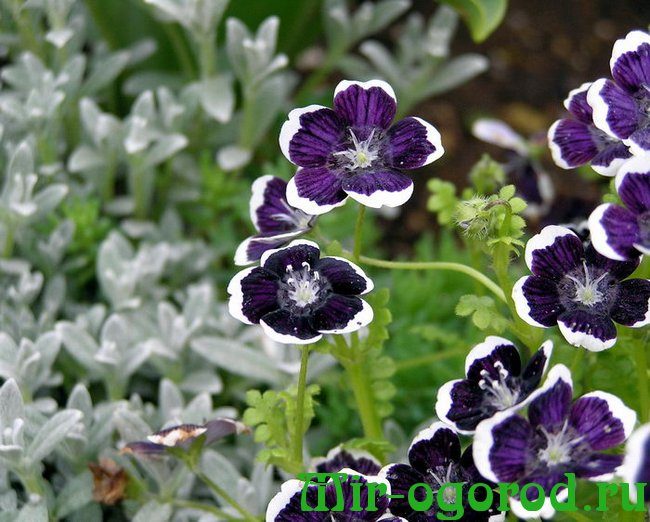
How to apply fertilizers, need for application, timing of application
Nemophila does not need special feeding. If, when planting seeds, you introduced a nutrient mixture and the soil in your area is saturated, then you can not feed anything else.
On poor soils, the plant is fed twice:
- during budding,
- during flowering.
Top dressing is done with fast-dissolving complex fertilizers, such as "Epin", "Tsikron", potassium humate.
Attention! Be careful with fertilizing. An overabundance of them will provoke a reverse reaction, and the plant may die. Competent feeding, timely watering and the right choice of planting site are the key to wonderful flowering.
Varieties and varieties of nemophila
Nemophila is a native of North America. The second name - American forget-me-not - the flower received due to its geographical origin. It is extremely rare in our latitudes, although it differs from other flowers in its beauty. But the Japanese respect the plant and even organize an annual festival dedicated to this type of flowers. It is called "Harmony of nemophiles", the most common of all plant varieties are present at the festival:
Spotted nemophila. The annual flower has a very interesting color. Small specks of purple or dark blue are symmetrically located on the white petals. The plant itself of this variety barely reaches 20-25 cm. The photo shows why the Americans call it “five specks”.
This annual flower comes in a variety of varieties. The most popular of them are:
- Coelestis - white petals with a blue border;
- Discoidalis or Penny Black - dark purple almost black petals with white edging;
- Oculata - blooms have small black spots in the core of the bud.
The variety of nemophila species does not include any perennial cultivar; this is the main disadvantage in choosing it as an ornamental plant on lawns.
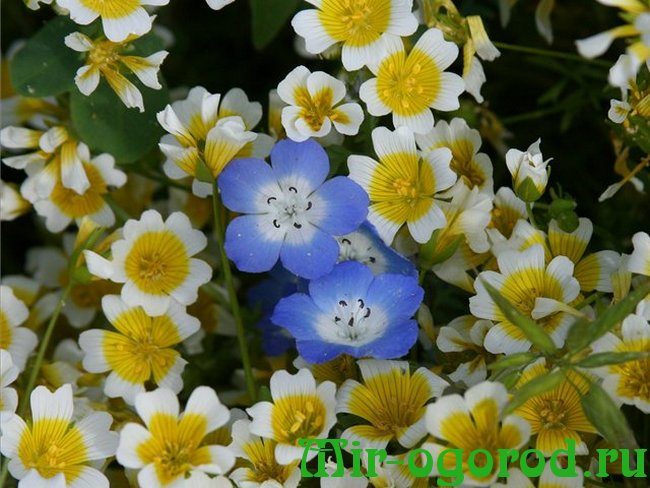

Growing tips
Nemophila can grow on well-drained light sandy substrates, but prefers soils enriched with manure or compost to stimulate annual spring growth. When introducing organic matter, additional feeding is not necessary. The growing position is sunny or partial shade. Excess moisture and prolonged flooding lead to the death of the root system, so it is best to plant the plant on a small hill or ensure a good outflow of water. American forget-me-not loves cool soil, so in hot summers, provide the plant with mulch to cool the soil and roots.
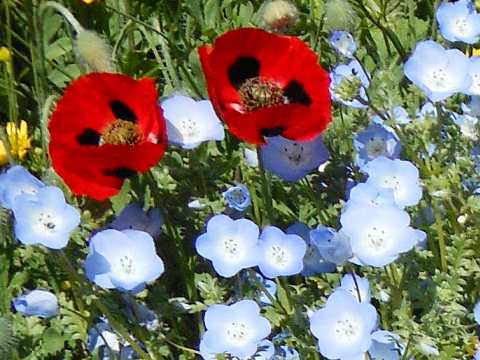

Planting technology nemophila
It is necessary to mix equal amounts of turf, sand and humus and add one tablespoon of chalk in powder form to neutralize the acidity. Pour the nutrient substrate into a container with drainage holes and pour boiling water over for disinfection. Half a month before planting in a permanent place, spread the seeds on top of the substrate and sprinkle a little with earth. Next, the container should be placed in a cool, slightly lit place and sprinkled with warm water from time to time. For proper growth of nemophila, it is necessary to plant seeds in open wet ground to a depth of half a millimeter and sprinkle with a thin layer of earth.
If you plant seeds in the summer, then the above manipulations are not necessary. After the green shoots appear, the seedlings should be thinned out and at the end mulch the soil under the nemophiles with matured compost or old peat.
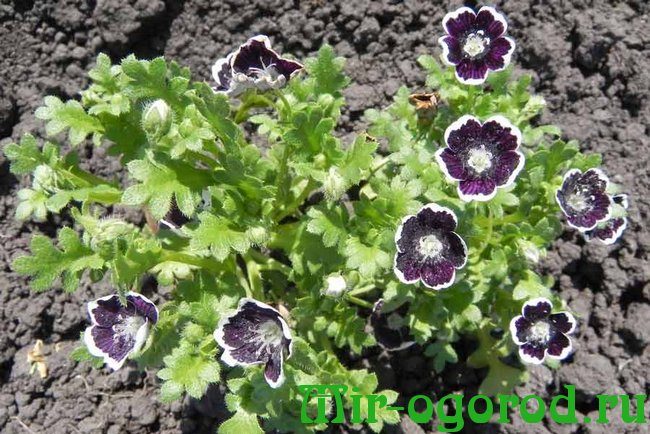

Principles of sowing flowers for seedlings
For sowing, peat pots, planting boxes or any other containers are used. The seeds are immersed in the soil 5 mm. If the planting is carried out in a box, then an interval of 5-7 cm between future bushes is observed.
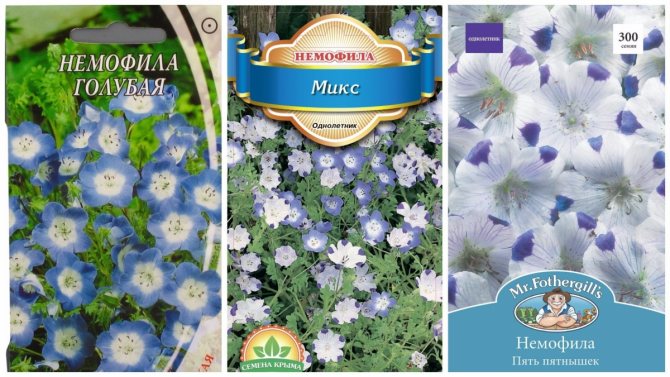

Photo: collage <>
When to sow
Growing nemophila from seeds can be carried out on the balcony. In order for the flower to bloom in June, it is necessary to sow for seedlings in April (in the middle lane) or March (in the south of Russia). To bloom in September-October, sowing is carried out in July.
Composition and preparation of soil
The substrate can be made up of sand, garden soil, and humus by mixing them in equal amounts. No fertilizer or top dressing is required.
Seedling care
Planting and caring for nemophila seedlings is simple. One of the main conditions for growing seedlings is maintaining the temperature within 25-27 ° C. In addition, good lighting must be provided. Instead of watering in the initial stages, it is recommended to spray the ground with a spray bottle.
Seedlings can begin to "stretch": the stems become thinner and brighter, new leaves do not grow. This is due to a lack of lighting. Therefore, plants need to be exposed to light or provide artificial lighting.
Until the first shoots appear, containers with seedlings must be kept under plastic wrap. As soon as shoots are formed, the shelter is removed. With spring warming, nemophila bushes begin to harden. For this, the seedlings are taken out into the open air. In the first days, no more than two hours, then increasing the time to eight.
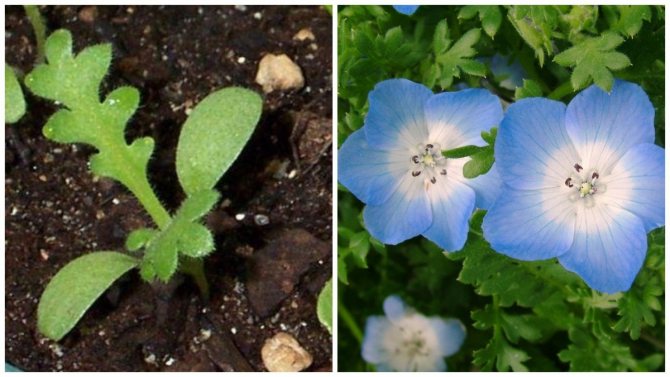

Photo: collage <>
Landing in an open area
In early May, young bushes that have reached a height of 10 cm are planted in a flower bed. If nemophila was grown in peat pots, then they are not removed from the container. If in a planting box, then release each bush very carefully so as not to damage the roots and shoots.A space of 15 cm is kept between the plants. If it is necessary to plant flowers so that they do not merge into one carpet, it is recommended to increase the distance between them.
Watering nemophila
The flowering time is a period of particular sensitivity to lack of moisture. Therefore, excessive dryness of the soil forces the plant to take protective measures: the leaves begin to sink to the ground, the flower buds stop growing, and may wither. If the weather is dry, it is necessary to irrigate two or three times a week, you can mulch the soil by scattering fine humus or peat to reduce the evaporation of moisture from the ground. It is important to loosen the soil between the bushes.
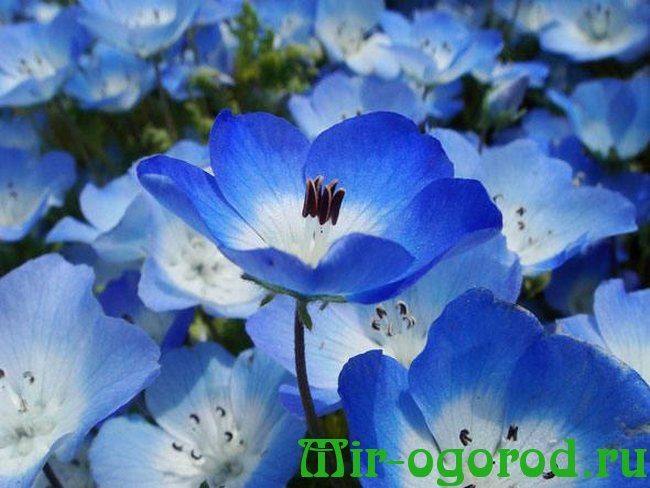

Basic rules for watering, the need for mulching
The plant is watered quite often, it is necessary to ensure that the roots do not dry out. Don't forget about mulching. It serves as a thermal insulation layer and reduces the germination of weeds. Fluff the soil before each watering. Watering should be done in the evening. In especially hot and dry weather, it is recommended to spray the flowers.
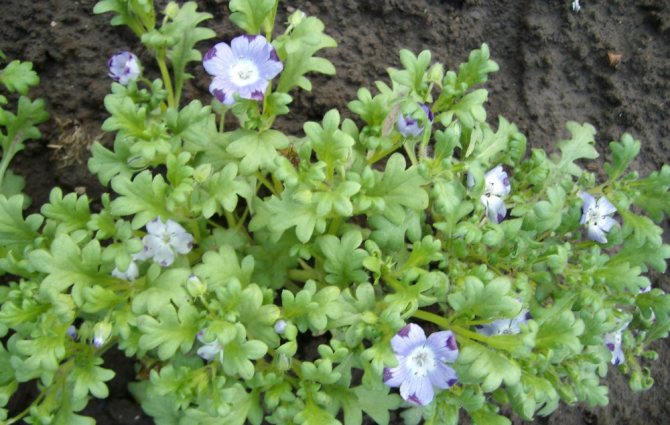

It is necessary to water the nemophila in the evening, it is important to ensure that the roots do not dry out.
Advice! Spray in the morning or in the evening so that the plant does not get burned from the heated water.
If you neglect these requirements, the plant will stop blooming.
Feeding nemophila
For the rapid development of Nemophila, in addition to watering, you can add additional fertilizing, it is enough to purchase a complex fertilizer. The amount of application of the drug can be read on the packaging. With this fertilizer, greens can be fed once or twice a season. The first time before the bud ovaries, the second time during active flowering.
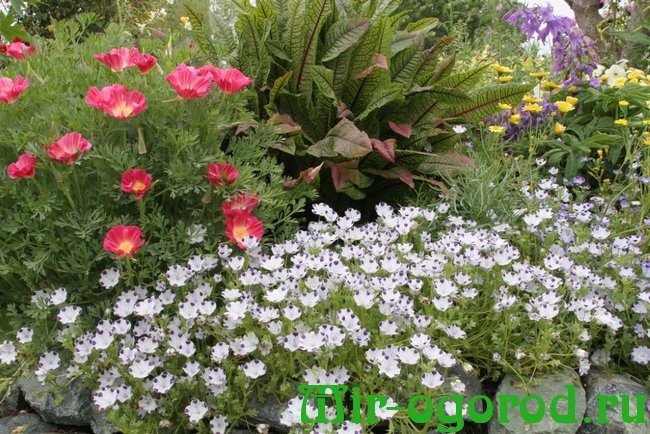

It is very easy to grow nemophila from seeds, even if this is the first flower in your garden, and you have never dealt with ornamental plants before. It can be sown directly into open ground due to the frost resistance of nemophila, and after that it is only enough to often water and mulch at the roots during dry periods. Perhaps, it could be called an ideal option for a garden landscape, if the flower were not an annual.
When you notice buds that have set on the shoots, carry out top dressing. Nemophila is fed with complex mineral fertilizers. Well, and of course, do not forget about the weeds, which not only spoil the appearance of the flower bed, but also prevent your beauty from growing. But pests are not afraid of nemophile, the only disease that can adversely affect its health is dryness.
Fresh articles about garden and vegetable garden
Spring Cherry Pruning for Beginners
Spring pruning for beginners
Apricot pruning: when and how to do it right?
Reproduction
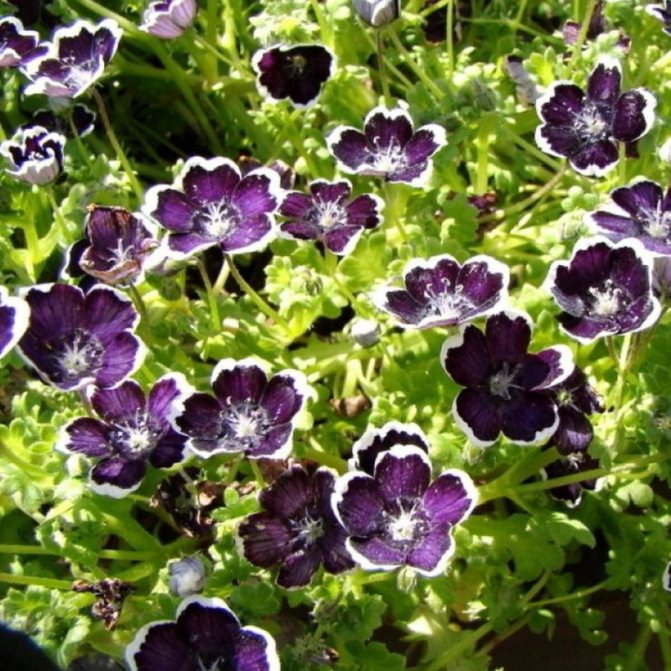

For nemophila, only seed propagation is used. You can collect the seed yourself from the flowers already in the garden, or buy it in the store.
Harvesting is carried out only after the bud is fully ripe: a seed capsule is formed in its place. It should be left on the stem for a while to dry, and then opened. After that, the seeds need to be shaken out into an envelope or cup. They are quite large, so it will not be difficult to do this.
Important! If there are several varieties, the envelopes must be signed accordingly.
The seed should be stored in a dry and cool place in paper packaging, so it will retain its properties until next spring.
Nemophila in landscape design
From several varieties, nemophila create ridges in combination with other low-growing plants. A special effect is achieved over a large area by planting nemophila in the form of waves with alternating plants of different colors. When this splendor blooms, gardeners get an original "sea" corner in their garden.
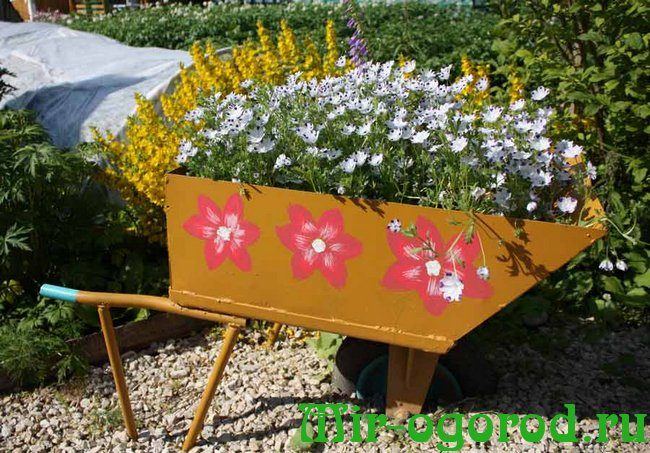

This plant can be used to decorate the garden well.Gardeners plant various nemophiles in the form of waves, thanks to this method, you can create a "marine" design in your garden. Also this plant is used as edging for flower beds and garden paths. They can also be planted in the form of lawns near water bodies. This plant is excellent for use as an additional element on an alpine slide. Nemophiles can also be grown in pots, this plant looks very good in hanging pots. Nemophila is combined with bells, phlox, daisies, creating different color schemes. Looks fun and colorful together with medicinal calendula and nasturtium. Nemophila's desired guest is on the alpine slides, where she successfully fills in the spaces between stones and coniferous plantings.
Pest control and disease control
Nemophila is affected by slugs. These gastropods destroy young shoots, which weakens the flower's immunity. You can get rid of pests with wood ash. It is scattered in the evening under the plants. Slugs can be fought with 9% table vinegar. For 10 liters of water, take 65 ml of vinegar. But it should be borne in mind that you cannot use the substance regularly, because it can burn the stems and leaves. One of the most reliable ways to protect plants from slugs is to identify the places of their accumulation on the site and destroy them. In the daytime, pests prefer to hide under stones, boards, and other objects in damp cool ground, and in winter - in compost pits.
Sometimes nemophila blooms poorly. This happens due to excess or lack of moisture.
Combination with other plants
Nemophila will look good with simple small flowers that are outwardly similar to each other. Against the background of roses, asters or lilies, they will get lost and become invisible. Therefore, in combination with similar plants, the whole composition will turn out to be gentle and pretty. These are plants such as:
- Forget-me-not;
- Bell;
- Iberis;
- Chinese carnation;
- Ursinia;
- Gatsania.
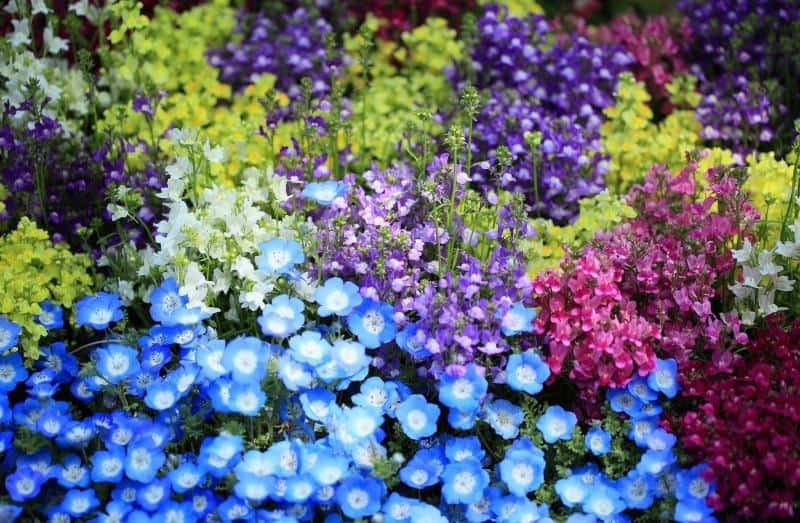

Nemophila will look good in a single planting, creating a carpet of flowers.
Although nemophila is not widespread in our country, this does not mean at all that it is unsuitable and unsuitable for our conditions. It is not popular only due to the ignorance of flower growers. Nemophila not only has unpretentiousness, but also looks beautiful, cute and gentle in a flower garden.
Care
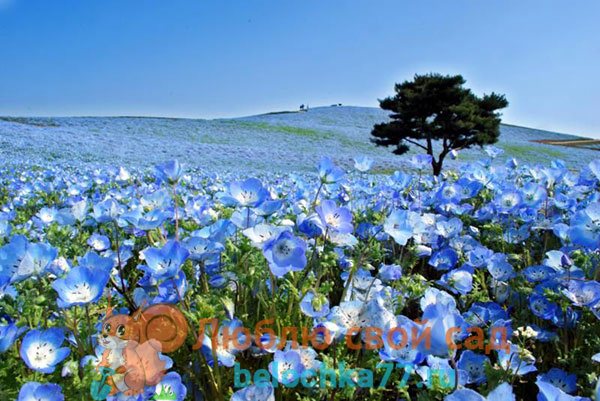

Do not allow overdrying of the soil in which the nemophila grows. The plant is sensitive to lack of moisture. If watering is sparse and scarce, leaves will fall on the flowers, and the buds will take on a drooping appearance and stop growing. It is desirable that the soil is loose and permeable. But Nemophila is less demanding on the nutritional value of the soil. The ideal soil for it will be a mixture of turf, humus and sand.
In hot weather, watering is carried out 2-3 times a week, after which loosening is required. During a drought, watering the plant is recommended even more often. To reduce moisture evaporation, the soil can be mulched with peat, humus, or grass cuttings.
Advice! Water the nemophila with warm water, ideally if the water temperature matches the air temperature.
Between the plants, be sure to remove all weeds so that they do not take away nutrients and moisture from the flowers. The procedure must be carried out as soon as the weed appears, so that it does not have time to give root suckers. When the nemophila grows into a solid carpet, there will be no room for weeds.
It is advisable to fertilize twice. The first time the nemophila is fertilized before setting buds. The second time fertilizer is applied during the active flowering phase. For feeding, a complex mineral fertilizer is used for flowering plants. The exact dosage can be found in the instructions on the package of the drug.
Outdoor planting
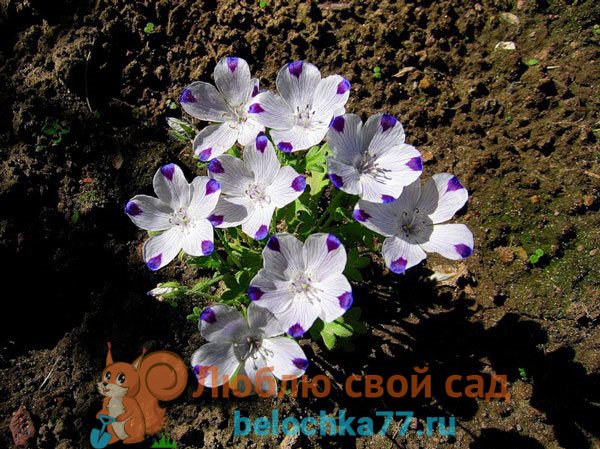

By the time of transplanting into open ground, the seedlings should be 8-10 cm high.If you want to get a solid carpet of nemophila on the flower bed, you need to plant the plants at a minimum distance from each other (15-20 cm). An annual can be sown with seeds directly into the ground, but in this case, flowering will come later. The planting depth of seeds in a flower bed should be no more than 2 cm.
On a note! The annual puts up well with partial shade. It can be planted where other flowers lack light. You can also plant a nemophila in an open area.
It is believed that in sunny areas, the color of flowers in an annual is brighter.
Collection and storage of seeds
An uncomplicated procedure is carried out after the end of flowering, when the capsules on thin stems have dried up. Do not wait until the base with the seeds is completely dry: you can "lose" some of the seeds, and self-sowing planting may not be so successful: the plant is not resistant.
After collecting, the boxes are carefully opened, the seeds are poured onto clean paper, the planting material is dried for several days in a warm, but not hot room. Prepared seeds are poured into paper bags or linen bags. The planting material is stored in a damp room at a moderate temperature: + 16 ... + 18 ° С.
Choosing a landing site
You can plant nemophila in open ground, and in a pot or flower bed. The main requirement of a plant is to comply with its basic needs.
Lighting
This plant cannot be called picky, demanding or capricious. It feels great both in partial shade and on the sunny side. It loves diffused light, but it will easily get used to the bright sun. Some growers have come to the conclusion that nemophila will bloom longer and brighter in intense sunlight.
The soil
The level of soil moisture is especially important for nemophila. When the earth dries up, the plant will simply stop blooming and begin to die. Because of their love for moisture, they often grow on the banks of water bodies. In this regard, it is worth paying attention to the permeability of the soil. The looseness and moisture of the earth is in the first place for nemophila. In addition to regular watering and loosening the soil, it is worth organizing mulching. The mulch will retain moisture in the ground longer, which will reduce the risk of drying out.
A good soil composition would be:
- Sand;
- Turf;
- Humus.
All these components should be in approximately equal proportions.
The acidity level should be at a neutral level. To normalize this indicator, add 1 tablespoon of crushed chalk to a bucket of soil mixture.
Gardeners reviews
Fleur
I liked the nemophila Baby Blue Eyes very, very much. The name corresponds - the flowers really look like blue eyes, they bloomed for a very long time.
Redfox, Moscow
Nemophila seemed to me like a calendula for the simplicity of cultivation. Sowed her empty spaces between the still young bushes. I sowed in May just in the OG, did not cover it with anything, sprinkled it with earth a little.
Home-made mayonnaise "Taste of childhood". Cooking recipe with photo
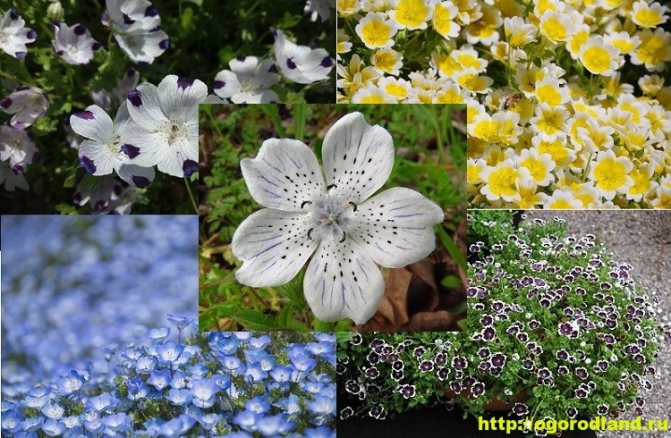

Nemophila is a flower bed decoration. Growing and varieties of nemophila Not all flower growers know such a beauty as nemophila. Nemophila bushes spread along the ground and are covered with small, delicate flowers.
Nemophila Is a low-growing herbaceous annual plant. Its height can be up to a quarter of a meter (25-30 cm). A nemophila flower with a diameter of 3 cm looks like a buttercup, and its petals have a complex feathery configuration.
The duration of flowering starts from the first days of summer and ends at the end of October (depending on the region). The flowers are white in color with drooping purple spots.
Nemophila requires timely watering, does not tolerate drought. On hot days, watering should be carried out in the evening.
When planting, it is advisable to add organic fertilizers to the soil.Nemophila loves land containing a large amount of humus, grows well in sunny and semi-shaded areas. Propagated exclusively by flowering seeds.
Popular varieties of Nemophila
The plant is bred in North America, it is also called "American forget-me-not" in our area. There are more than a hundred species of this flower all over the world.
The most popular and popular among flower lovers are the following varieties: Menzis, Atomaria, Nemophila spotted, Peni Black and Coelestis.
- Flower "Menzisa" is similar in shape to a bell, it is white or sky-colored, has spotted heads and leaves.
- In the bloom of Atomaria, small black dots are visible, and the whole flower is colored white.
- The variety "Nemofila spotted" differs from other species in the large bell-shaped flower of a whitish-purple color. Plant height reaches 20 centimeters.
- The variety of nemophila "Peni Black" has flowers of a very rich purple color, which from afar may appear black.
- As for the Koelestis variety, the flowers of this variety are whitish with an unusual blue edging.
Growing tips and care for nemophila
The plant is considered disease resistant and can grow in areas with different climates. It will not be difficult to grow it by seed on your own at home.
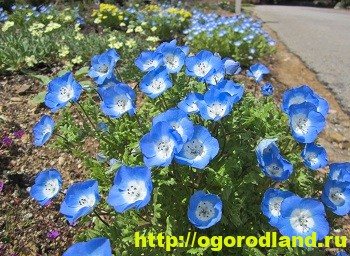

Nemophila Menzisa
Although the flower has established itself as a picky species and can breed in areas with varying amounts of UV exposure, it is best to sow seeds in a sunny location. Since in a sunlit flower bed, ripe buds will be large, and the stems will be strong. The flowering period of nemophila is June-September. Before sowing nemophila seeds, it is necessary to prepare the soil, it is imperative to moisten it and loosen it. Planting flowers begins in the last days of March and may end in the end of spring.
Sown nemophila in early spring will give the first flowering in early summer, and late planting - in early autumn. The first shoots appear after sowing in a few weeks.
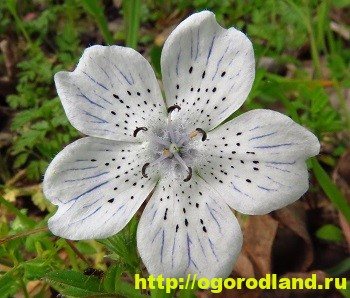

Nemophila Atomaria
It is undesirable to cover the seed hole with a large layer of soil. The acceptable value is half a centimeter from the ground. The distance between the unit of the seed should be at least 10 cm, 20 cm is possible. Such gaps will allow you to get a luxurious carpet from nemophila in the future.
You should know! Nemophila is a plant that does not like transplanting. If the seeds were grown indoors, then it is forbidden to plant them on street soil. Otherwise, the plant will disappear.
Despite all the unpretentiousness of this species, it needs constant monitoring and care. After planting seeds in the ground, you need to monitor the moisture content of the hole. Good plant maintenance requires regular watering, especially during dry seasons. If the soil on which the plant is planted is dry, then there is a high probability that it will die. It is recommended to moisten the soil daily with cold water in the first week after planting the seeds.
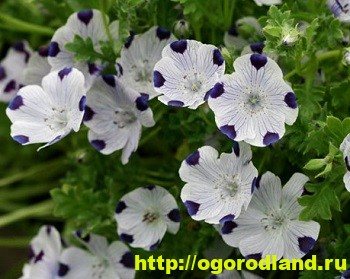

Nemophila spotted
For the normal development of the flower, it is necessary to remove the unwanted alien plants (weeds) that have grown.
Feeding Nemophila is carried out with complex mineral fertilizers after the first buds appear and then several more times during the flowering season. Fertilize the ground for plantings with chalk or humus. The most effectively prepared soil for sowing is an equal ratio of humus, sand and sod substrate and one spoonful of chalk per bucket of the whole mixture. If the seeds are planted densely in a row, then the sprouted stems must be thinned out, leaving a distance of at least 20 cm between the units. Such maintenance measures will promote the good development of a flower with a healthy large bud.
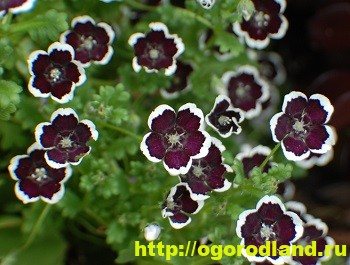

Nemophila Peni Black
The advantage of this plant is that it excludes treatment with various chemical agents against pests. Since the flower is not attacked by various harmful insects, with the exception of slugs, which damage young shoots. Nemophila also has a high level of frost resistance, easily tolerates frost.
Seed collection should be carried out after the bud is fully ripe. Nemophila seeds are large, so when collecting it is better to shake them out of the flower into some kind of plastic container or cup. Also, the flower can self-propagate by winding uncollected seeds from the plant boll.
If during flowering there is a decrease in buds on the bush, these are the consequences of a lack of nutrients. In this case, it is advisable to carry out more abundant feeding with various organic fertilizers under the bush and to increase the watering of the planting soil.
The plant can produce several blooms per season. To do this, you need to prune in mid-summer. The formed bushes will look neat and pruning will contribute to the abundant budding of the nemophila.
Nemophila in landscape design
The flower is a wonderful decoration for any landscape area. It can be planted in a variety of garden shapes and arrangements, creating a unique garden design.
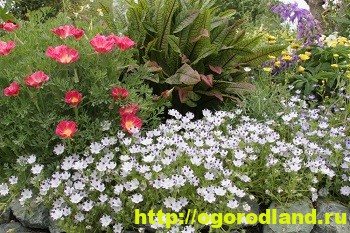

Nemophila in landscape design
For example, plant blue flowers in the form of waves or along the edge of a flower bed, the sides of the path in the garden. Modern gardeners often use the plant as a zoning area for plantings. Therefore, this species is popular all over the world.
The nemophila bloom cluster near reservoirs or a pond looks gorgeous. Also, the planting will be appropriate on an alpine slide, as its complementary element. The plant can be grown in drained soil. In this case, it will not allow moisture to stagnate in the soil. Often, nemophiles are grown in hanging and ordinary "pot" products.
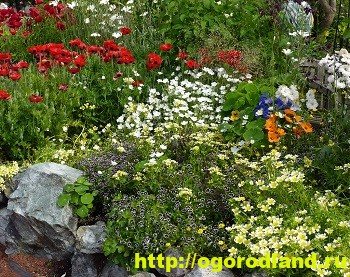

The combination of nemophila with other colors
These flowers get along well with other types of plants. Thus, you can create a gorgeous flower bed with a combination of different varieties and types of annuals.
Nemophila goes well in planting with large white or colored daisies, calendula, bells and phlox.
A convenient plant for growing in multi-storey buildings. You can decorate the balcony with hanging nemophila pots in a uniform style or in combination with other similar plant species.
Today the flower is more popular in Western countries than in Eastern Europe.
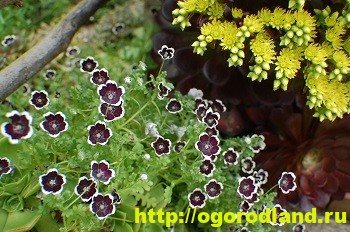

Nemophila on an alpine slide
For example, in the Japanese National Seaside Park Hitachi. There, a nemophilous sky-colored hill is dotted with over 4 million flowers, creating a breathtaking view overlooking the ocean. Thousands of tourists visit the park every year, admiring the heavenly beauty of the plant. Also, most often you can find the most beautiful Nemophila fields in the USA, Canada and Mexico. As a result, we can say that "American forget-me-not" is an excellent option for ornamental plantings in different climates. This is a non-painful flower with good frost resistance. According to experts, this species will be more and more common in Russia every day and will increase the demand among lovers of flower plantings. After all, the flower is distinguished not only by its unpretentiousness in care, but also by its amazing delicate appearance.
Excellent (2) poor (0)

